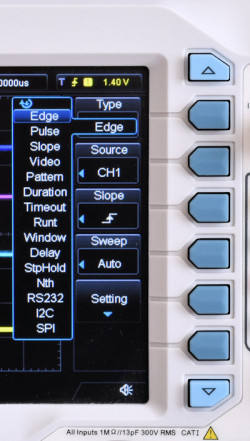Review: Rigol DS1054Z Four-Channel Oscilloscope

Getting started
Operating the oscilloscope takes some getting used to becaus of the many buttons around the screen. But otherwise, the design of the controls is similar to other devices in this price range. This also applies to the selection of channels using four push buttons. At the bottom of the display, you can see which channel is currently active. You should always take a look at this before turning the buttons for the vertical setting!The combination of available bandwidth and maximum sample rate is well chosen for this oscilloscope. You might find the input bandwidth of 50 MHz a bit low. But that is sufficient for most applications, as long as you are not really working with HF circuits. Remember that the samplng rate drops to half or a quarter when using 2 or 3..4 channels simultaneously. At 50 MHz, you only have 5 samples/periods left, which is far too little for a good reconstruction of the signal. So that combination of input bandwidth and sampling rate is really fine!

The display of the DS1054Z is easy to read, even at an angle. I did have a tendency to set the brightness a little higher. A lot of information is visible on the screen, mainly due to the presence of the menus associated with the push buttons on both sides of the screen. All in all, that does give a fairly busy picture, because a number of things are also shown at the top and bottom of the display. The available space for displaying the waveforms is therefore relatively small.
Read full article
Hide full article


Discussion (0 comments)